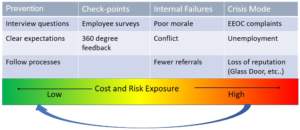Why do so many organizations constantly operate in crisis mode? Do we secretly enjoy the emergencies that keep us working late, only to come home for worry-filled, sleepless nights? That can’t be right!

I recently presented to a group of business leaders and discussed the cost of quality. During my presentation I explained that we explore the root causes of failures to determine how we can prevent them from happening again. Then, we invest in preventive activities which results in decreased failures. These investments can ultimately save us time, money, and even our reputation. It is a cycle of continuous improvement. One participant commented that this is really common sense and something we should already know. She was absolutely right. So why don’t we follow these best practices? The story below may help to explain.
An HR professional, we’ll call her Maria, has been consumed with several serious issues, including poor morale, high turnover, and even an EEOC complaint. Maria is so preoccupied with putting out all of these fires that she rushes to fill empty seats. She has to put off training and doesn’t touch base with the latest group of new hires to see how they are adjusting. Maria fully intends to circle back with these employees and get back on track as soon as she resolves the latest crisis. The only problem is that one of the new hires is already having performance issues due to several red flags that were ignored during the hiring process. Maria has now been handed her latest crisis. Unfortunately, those preventive actions will have to continue to wait…and so the cycle continues.
When an organization is always operating in crisis mode there is never enough time or available resources to shift the focus over to prevention. It is also difficult to draw a straight line between prevention and profits, so it can be a challenge to get funding for preventive activities. But in our example, if Maria’s organization uses root cause analysis to identify why employees are unhappy and leaving, and whether they could have taken steps to prevent that EEOC claim, they can implement improvements to bring the organization back from the brink.
I know a little about this, because once upon a time I was “Maria”. Thankfully, I was able to work with our executive leadership team to make incremental improvements to our processes and move us out of crisis mode and into prevention. We saved time and money, and I started to sleep better at night.
If you are in this situation and ready to fix it, you will have to acknowledge a few things:
1) This will not happen organically. Continuous improvement is intentional.
2) You will need to dedicate time and resources to the process improvement effort. It should be treated like a project.
3) It will be necessary to establish metrics to measure your progress. Turnover rate, employee survey results, or even absenteeism can be relevant metrics to help you determine if you are making progress.
4) This will not happen overnight. Use the concept of “kaizen”, where all employees work together to achieve small, incremental improvements.
5) It will be worth it!
Barb Waters is a project management enthusiast and owner of Peak Business Management in Edwards, Colorado. When she notices a better way to do things, she enthusiastically shares it through her training classes and blog.
